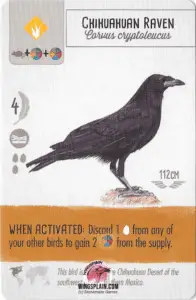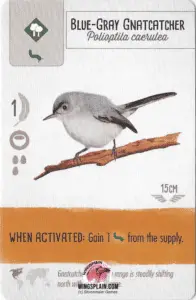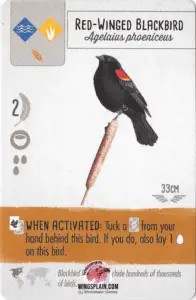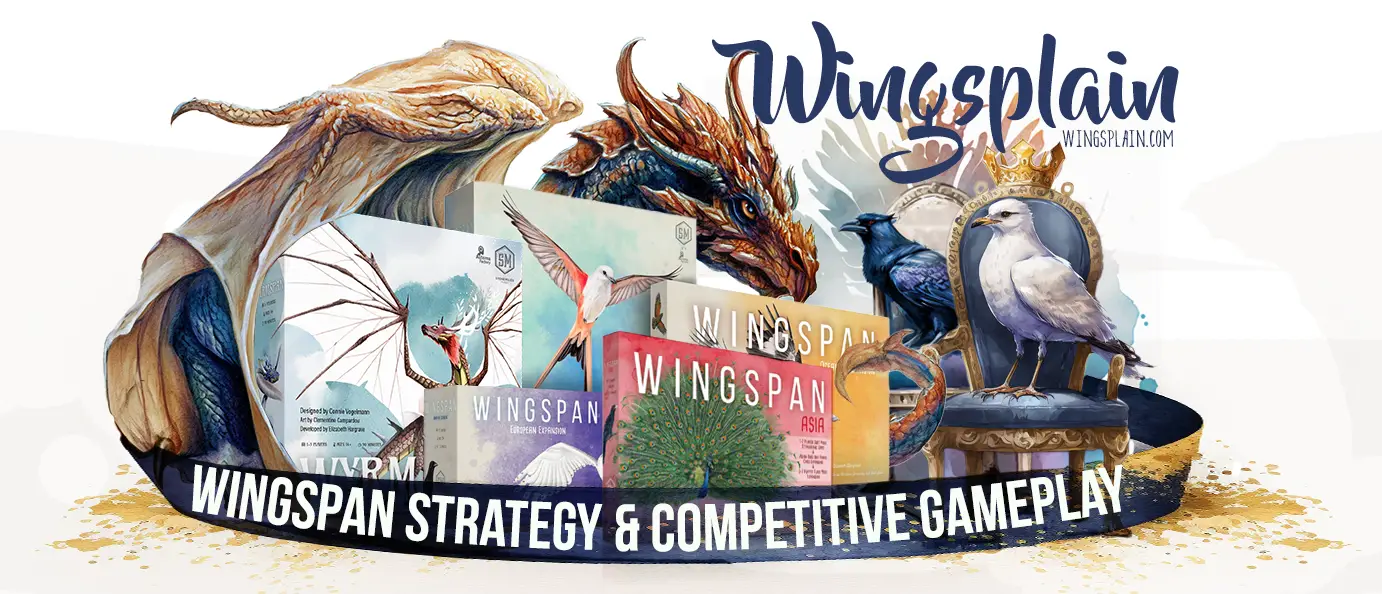How good are Chihuahuan Raven and Common Raven in Wingspan?
Chihuahuan Raven and Common Raven are considered to be among the best cards in Wingspan. Those who have played Wingspan for a while don’t need to be introduced to them. They have been the center of online discussions since people first cracked open the game in early 2019.
Why is that? At first glance, they might not seem like anything special to a new player. See also: The Best Cards in Wingspan, and How to Beat the Best Cards in Wingspan.
Traits of Chihuahuan Raven

- Food Cost: 1 Rat +2 Wild. Expensive but flexible.
- Nest Type: Platform. Nothing special here.
- Egg Capacity: 3. Average
- Victory Points: 4
- Habitats: Grasslands. Restrictive on paper, no big deal in practice. You want this guy in the Grasslands anyway.
Traits of Common Raven

-
- Food Cost: 1 Rat +2 Wild. Expensive but flexible.
- Nest Type: Platform. Nothing special here.
- Egg Capacity: 2. Below Average
- Victory Points: 5
- Habitats: All, which allows for maximum versatility. You’re going to want to play this in the Grasslands most of the time, but it can be useful in the Wetlands under certain conditions. I have employed a Forest Raven on a couple of occasions in an attempt to recover from a food starved round one and two. This requires that you have an previously established egg supply.
From our Alphabetical Analysis Series:
Chihuahuan Raven
Restricted to the Grasslands, but that doesn’t impact this bird’s effectiveness since it wants to live there any way to fuel its power. Falls under the umbrella of Rodentologist, Large Bird Specialist, and Platform Builder along with predator birds. Omnivore Specialist adds two more points to it as well. It’s a good point bomb with the right bonus card.
Considered to be one of the most powerful cards in the game, spurring the implementation of various house rules to put it in check. Its power continues to impact the metagame by allowing Egg Spam strategies to generate food and victory points (through eggs) at the same time, ignoring the Forest altogether. It became even more powerful with the Oceania Expansion and the introduction of nectar. When paired with Franklin’s Gull or Killdeer in the Grasslands, it can be devastating to your opponents.
Common Raven
Tri-Habitat increases your options if you can supply it with eggs in the Forest or Wetlands, but it generally wants to live in the Grasslands to consistently fuel its power. See Chihuahuan Raven above for more. These two birds are very similar.
Chihuahuan Raven and Common Raven Brown Power
“When Activated: Discard 1 egg from any of your other birds to gain 2 -any food- from the supply.”
This is what sparks so much discussion. What people end up discovering in practice is that having these birds in the grasslands habitat alters the action economy of the game. Getting one down in the grasslands early has the effect of allowing you to bypass the food generation aspect of the game (the Gain Food Action) while generating eggs, the very fuel that the Ravens ask for. One Raven ends up facilitating a food and egg engine in of itself by virtue of using the Lay Eggs Action. Eggs result in victory points, allow you to play more birds deeper into your habitats, and they produce food via Ravens.
There are some limiting factors though. Ravens are expensive and they can’t consume their own eggs. They also tend to have reduced impact as you enter into the mid and late game (although I have employed a round three Raven to assist with a food starved game to great effect on several occasions). The most impact that they have occurs when they are played sometime in the first round. The sooner the better.
The reason for this is that as you advance into later rounds, they have less time to generate more impactful snowball effects. There are 26 total activations that occur each game and round 1 represents 30% of the total game. Round 4 by comparison represents 19% of the game, nearly 50% less time to score points.
These factors mean that Ravens want to be played as early as possible and they need a buddy to help them out with that. Cheap cards that generate resources and can hold a couple of eggs, such as Blue-Gray Gnatcatcher, are perfect for this.

Hypothetical Scenario Play-Throughs
Let’s go through a couple of hypothetical scenarios to showcase what these cards can do:
Scenario #1:
Keep Common Raven, Blue-Grey Gnatcatcher, 1 Rat, 1 Worm, and 1 Cherry from your opening hand. The Gnatcatcher is going to give you extra food support.
Note: If there is a card drawing bird in the tray, such as a Ruddy Duck or Mallard, it would be best to secure that first with the Draw Cards Action, before you make any other plays. This will put you in a better position in the future to draw more cards and take advantage of the food and eggs you will be generating. Getting important cards like this before your opponents can snatch them up is an important tactical move.
- Activation #1: Play A Bird Action: Play the Gnatcatcher into your forest. Pay 1 Worm (1 Rat/1 Cheery remain).
- Activation #2: Gain Food Action: Gain 1 food of your choice from the birdfeeder (1 Rat/1 Cherry/1 “Other” remain).
-
- Activate Gnatcatcher: Gain 1 Worm from the supply (1 Rat/1 Cherry/1 Worm/1 “Other” remain).
- Activation #3: Play A Bird Action: Play the Common Raven into your Grassland, paying 1 Rat, 1 Worm, and 1 Cherry (1 “Other” remains).
Now the engine is online. You have 1 food left, no cards, and 5 activations remaining in Round 1. At this point, you want to look at the cards in the tray. They should have given you some input on how your next actions would play out.
Did an opponent reveal a Mallard and you still have a worm from the Gnatcatcher? The Mallard would complement your board well at this point. You would be able to draw 2-3 birds (discarding an egg for the 3rd card) which gives you a lot of options to build off of. The Raven has put you in the position to easily play anything you draw into without worrying about the Gain Food action. Alternatively, this might be the point where you want to lay some eggs to meet the Round 1 bonus, start setting up for later round bonuses or fulfilling the requirements of your bonus card.

It should be noted that using a zero food cost Vulture (Black Vulture, Turkey Vulture, Griffon Vulture) will allow you to get a Raven online and ready to produce food by activation #3. The drawbacks of using a Vulture may or may not bother you. They can only hold a single egg and pink powers are generally less effective with fewer players.
Let’s look at another hypothetical scenario. The Common Raven winds up in the Wetlands. For this to work optimally, we’re going to have to have egg generation in the wetlands as well. This requires specific cards that I refer to as “Tuck/Lay Birds” such as the Red Winged Black Bird.

Scenario #2:
- Note the Common Raven in our imaginary tray. As luck would have it, you’re player #1. Keep Red Wing Black Bird, 1 wheat, 1 Rat, 1 Worm, and 1 Fish from your opening hand.
- Activation #1: Draw Cards Action: draw Common Raven from the tray to ensure that you get it. (2 cards in hand)
- Activation #2: Play A Bird Action: Play Red-Winged Black Bird in the wetlands. (1 card in hand)
- Activation #3: Draw Cards Action: Draw 1 card. (2 cards in hand)
-
- Activate Black Bird: Tuck a card and lay an egg. (1 card in hand)
- Activation #4: Play a Bird Action: Play Common Raven in the 2nd slot of the Wetlands, discarding the egg off the Blackbird and using your remaining food. (0 cards in hand)
- Activation #5: Draw Cards Action: Draw 2 (2 cards in hand)
-
- We skip the Raven since we don’t have any eggs.
- Activate Black Bird: Tuck a card and lay an egg. (1 card in hand)
- Activation #6: Draw Cards Action: Draw 2 (3 cards in hand)
-
- Activate Raven: Discard 1 egg for 2 of any food. If you like the cards you just drew, you’ll obviously want food to play them.
- Activate Black Bird: Tuck a card and lay an egg. (2 cards in hand)
At this point, we are in a position to play one of the two cards in hand. We have two food and 1 egg. There are two activations left in the round. Is it worth getting on the board for the round 1 bonus? If the cards aren’t what you’re looking for and you can’t get the bonus, keep digging deeper into the deck and generating food. You will hit something worth playing in short order. Note that your scoring VP through Tuck/Lay each time you draw cards.
As you can see from these two hypothetical scenarios, the Chihuahuan Raven and Common Raven can be leveraged into distorting the action economy heavily in your favor.
In the next article, I’m going to discuss two similar yet different birds and the impact that they have on the game. Franklin’s Gull and Killdeer. Combined with the Raven’s, these two cards round out what I have referred to in the past as, “The Power Four”.


